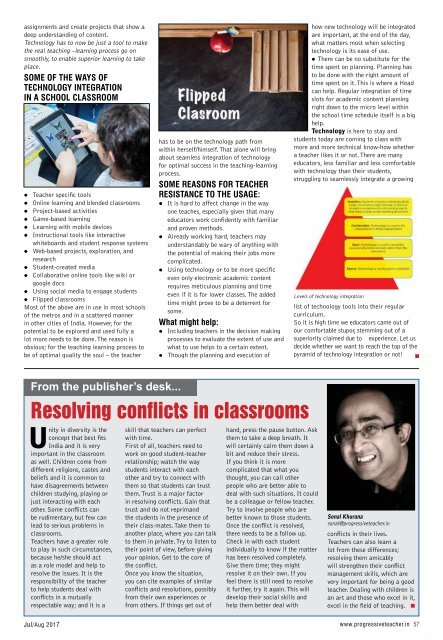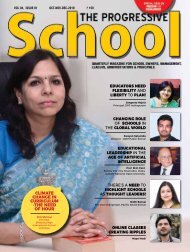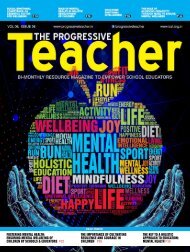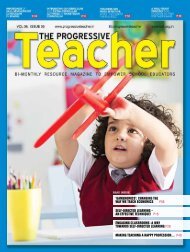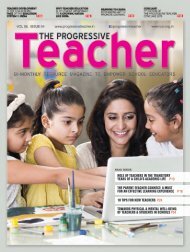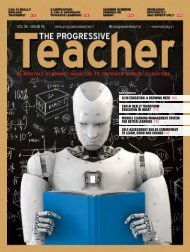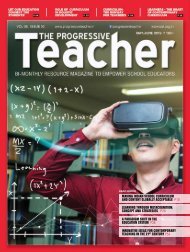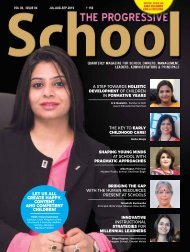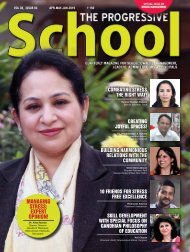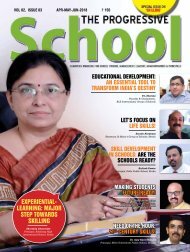The Progressive Teacher Vol 04 Issue 03
This issue of The Progressive Teacher focuses on "New Trends in Education ". In this edition, articles explore contemporary trends to enhance interactive learning amongst students.
This issue of The Progressive Teacher focuses on "New Trends in Education ". In this edition, articles explore contemporary trends to enhance interactive learning amongst students.
Create successful ePaper yourself
Turn your PDF publications into a flip-book with our unique Google optimized e-Paper software.
assignments and create projects that show a<br />
deep understanding of content.<br />
Technology has to now be just a tool to make<br />
the real teaching –learning process go on<br />
smoothly, to enable superior learning to take<br />
place.<br />
SOME OF THE WAYS OF<br />
TECHNOLOGY INTEGRATION<br />
IN A SCHOOL CLASSROOM<br />
• <strong>Teacher</strong> specific tools<br />
• Online learning and blended classrooms<br />
• Project-based activities<br />
• Game-based learning<br />
• Learning with mobile devices<br />
• Instructional tools like interactive<br />
whiteboards and student response systems<br />
• Web-based projects, exploration, and<br />
research<br />
• Student-created media<br />
• Collaborative online tools like wiki or<br />
google docs<br />
• Using social media to engage students<br />
• Flipped classrooms<br />
Most of the above are in use in most schools<br />
of the metros and in a scattered manner<br />
in other cities of India. However, for the<br />
potential to be explored and used fully a<br />
lot more needs to be done. <strong>The</strong> reason is<br />
obvious; for the teaching learning process to<br />
be of optimal quality the soul – the teacher<br />
has to be on the technology path from<br />
within herself/himself. That alone will bring<br />
about seamless integration of technology<br />
for optimal success in the teaching-learning<br />
process.<br />
SOME REASONS FOR TEACHER<br />
RESISTANCE TO THE USAGE:<br />
• It is hard to affect change in the way<br />
one teaches, especially given that many<br />
educators work confidently with familiar<br />
and proven methods.<br />
• Already working hard, teachers may<br />
understandably be wary of anything with<br />
the potential of making their jobs more<br />
complicated.<br />
• Using technology or to be more specific<br />
even only electronic academic content<br />
requires meticulous planning and time<br />
even if it is for lower classes. <strong>The</strong> added<br />
time might prove to be a deterrent for<br />
some.<br />
What might help:<br />
• Including teachers in the decision making<br />
processes to evaluate the extent of use and<br />
what to use helps to a certain extent.<br />
• Though the planning and execution of<br />
how new technology will be integrated<br />
are important, at the end of the day,<br />
what matters most when selecting<br />
technology is its ease of use.<br />
• <strong>The</strong>re can be no substitute for the<br />
time spent on planning. Planning has<br />
to be done with the right amount of<br />
time spent on it. This is where a Head<br />
can help. Regular integration of time<br />
slots for academic content planning<br />
right down to the micro level within<br />
the school time schedule itself is a big<br />
help.<br />
Technology is here to stay and<br />
students today are coming to class with<br />
more and more technical know-how whether<br />
a teacher likes it or not. <strong>The</strong>re are many<br />
educators, less familiar and less comfortable<br />
with technology than their students,<br />
struggling to seamlessly integrate a growing<br />
Levels of technology integration<br />
list of technology tools into their regular<br />
curriculum.<br />
So it is high time we educators came out of<br />
our comfortable stupor, stemming out of a<br />
superiority claimed due to experience. Let us<br />
decide whether we want to reach the top of the<br />
pyramid of technology integration or not!<br />
From the publisher’s desk...<br />
Resolving conflicts in classrooms<br />
Unity in diversity is the<br />
concept that best fits<br />
India and it is very<br />
important in the classroom<br />
as well. Children come from<br />
different religions, castes and<br />
beliefs and it is common to<br />
have disagreements between<br />
children studying, playing or<br />
just interacting with each<br />
other. Some conflicts can<br />
be rudimentary, but few can<br />
lead to serious problems in<br />
classrooms.<br />
<strong>Teacher</strong>s have a greater role<br />
to play in such circumstances,<br />
because he/she should act<br />
as a role model and help to<br />
resolve the issues. It is the<br />
responsibility of the teacher<br />
to help students deal with<br />
conflicts in a mutually<br />
respectable way; and it is a<br />
skill that teachers can perfect<br />
with time.<br />
First of all, teachers need to<br />
work on good student-teacher<br />
relationship; watch the way<br />
students interact with each<br />
other and try to connect with<br />
them so that students can trust<br />
them. Trust is a major factor<br />
in resolving conflicts. Gain that<br />
trust and do not reprimand<br />
the students in the presence of<br />
their class-mates. Take them to<br />
another place, where you can talk<br />
to them in private. Try to listen to<br />
their point of view, before giving<br />
your opinion. Get to the core of<br />
the conflict.<br />
Once you know the situation,<br />
you can cite examples of similar<br />
conflicts and resolutions, possibly<br />
from their own experiences or<br />
from others. If things get out of<br />
hand, press the pause button. Ask<br />
them to take a deep breath. It<br />
will certainly calm them down a<br />
bit and reduce their stress.<br />
If you think it is more<br />
complicated that what you<br />
thought, you can call other<br />
people who are better able to<br />
deal with such situations. It could<br />
be a colleague or fellow teacher.<br />
Try to involve people who are<br />
better known to those students.<br />
Once the conflict is resolved,<br />
there needs to be a follow up.<br />
Check in with each student<br />
individually to know if the matter<br />
has been resolved completely.<br />
Give them time; they might<br />
resolve it on their own. If you<br />
feel there is still need to resolve<br />
it further, try it again. This will<br />
develop their social skills and<br />
help them better deal with<br />
Sonal Khurana<br />
sonal@progressiveteacher.in<br />
conflicts in their lives.<br />
<strong>Teacher</strong>s can also learn a<br />
lot from these differences;<br />
resolving them amicably<br />
will strengthen their conflict<br />
management skills, which are<br />
very important for being a good<br />
teacher. Dealing with children is<br />
an art and those who excel in it,<br />
excel in the field of teaching.<br />
Jul/Aug 2017<br />
www.progressiveteacher.in 57


